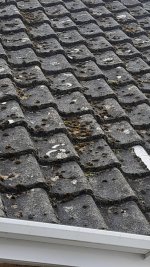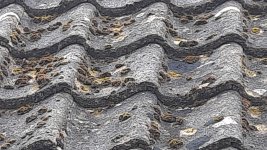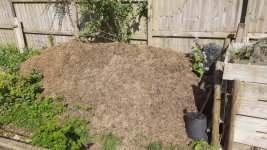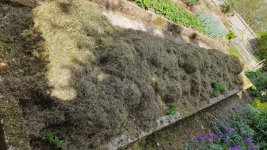-
Hi all and welcome to TheWoodHaven2 brought into the 21st Century, kicking and screaming! We all have Alasdair to thank for the vast bulk of the heavy lifting to get us here, no more so than me because he's taken away a huge burden of responsibility from my shoulders and brought us to this new shiny home, with all your previous content (hopefully) still intact! Please peruse and feed back. There is still plenty to do, like changing the colour scheme, adding the banner graphic, tweaking the odd setting here and there so I have added a new thread in the 'Technical Issues, Bugs and Feature Requests' forum for you to add any issues you find, any missing settings or just anything you'd like to see added/removed from the feature set that Xenforo offers. We will get to everything over the coming weeks so please be patient, but add anything at all to the thread I mention above and we promise to get to them over the next few days/weeks/months. In the meantime, please enjoy!
You are using an out of date browser. It may not display this or other websites correctly.
You should upgrade or use an alternative browser.
You should upgrade or use an alternative browser.
Moss Mountains
- Thread starter CHJ
- Start date
SamQ aka Ah! Q!
Old Oak
Tell me that is from power scarifying! You must be built on the same lines as Popeye if you did that with a hand rake....
Yes, we have a little help, treated ourselves to a new toy so that we can at least try to hit it as soon as we see it getting above its station in future.Tell me that is from power scarifying! You must be built on the same lines as Popeye if you did that with a hand rake....

Not that we are too precious about the patches of grass but when the Lawn mower starts getting bogged up to its axles in a bouncy cushion folks start passing comments.
It's when you can't see the folk is when you know you really have a problem 
AJB Temple
Sequoia
- Joined
- Apr 15, 2019
- Messages
- 7,331
- Reaction score
- 847
We actively try to encourage moss. It suits our garden. But is not for everyone.
Earlier today I remarked elsewhere that I remain completely confused on the subject of moss around here and soil acidity, Moss is an acid loving and generating species, this is a Limestone area, I can dig down a couple of foot and retrieve Cotswold Limestone suitable for building construction, how come I need to apply a heavy dressing of Lime everywhere to discourage it.
Mulling over the conundrum of rampant moss whilst doing a bit of remedial wall painting (it’s raining again) I believe I've answered my own localised befuddled battle with moss.
1. To rapidly kill lush green growing moss you introduce it to Iron sulphate; it turns black within minutes of exposure.
2. Iron Sulphate is an acidic salt.
3. Residual amounts of which entering the soil raises the acidity level of the loam.
4. Residual Moss spores rejoice at the increased acidity level of the surface loam and come out to play in profusion at the first opportunity.
And so the Man - Moss dance continues.
Mulling over the conundrum of rampant moss whilst doing a bit of remedial wall painting (it’s raining again) I believe I've answered my own localised befuddled battle with moss.
1. To rapidly kill lush green growing moss you introduce it to Iron sulphate; it turns black within minutes of exposure.
2. Iron Sulphate is an acidic salt.
3. Residual amounts of which entering the soil raises the acidity level of the loam.
4. Residual Moss spores rejoice at the increased acidity level of the surface loam and come out to play in profusion at the first opportunity.
And so the Man - Moss dance continues.
AJB Temple
Sequoia
- Joined
- Apr 15, 2019
- Messages
- 7,331
- Reaction score
- 847
Nature always wins. She's playing the long game.Earlier today.....
And so the Man - Moss dance continues.
SamQ aka Ah! Q!
Old Oak
Nice bit of kit!Yes, we have a little help, treated ourselves to a new toy so that we can at least try to hit it as soon as we see......bouncy cushion folks start passing comments.
A bit of an expensive indulgence though, just hope the faith in the brand name is matched by the battery and motor life.Nice bit of kit!
Could do with another battery for convenience in use but the thought of another £100+ sitting on the shelf most of the year and possibly deteriorating is a bit too much to swallow.
SamQ aka Ah! Q!
Old Oak
Amen!A bit of an expensive indulgence though, just hope the faith in the brand name is matched by the battery and motor life.
Could do with another battery for convenience in use but the thought of another £100+ sitting on the shelf most of the year and possibly deteriorating is a bit too much to swallow.
Woodbloke
Sequoia
...and here was I in Kanazawa trying to have a conversation:We actively try to encourage moss. It suits our garden. But is not for everyone.

...with some ladies sporting pointy hats who were diligently removing weeds (by hand) from the moss. I was trying to enquire (without success) the reason for each one burning a pot of incense as they worked. Keeps the mossie's at bay apparently - Rob
AJB Temple
Sequoia
- Joined
- Apr 15, 2019
- Messages
- 7,331
- Reaction score
- 847
^^ The moss gardens are spectacular. Complete reversal of the western aesthetic. I don't remember the incense burners being used by workers. Probably not observant enough.
Woodbloke
Sequoia
It's the second time I've seen ladies doing this; each time they were dressed in blue outfits with conical headgear and each time they were burning incense as they worked - Rob^^ The moss gardens are spectacular. Complete reversal of the western aesthetic. I don't remember the incense burners being used by workers. Probably not observant enough.
duke
Old Oak
What changed the acidity soil levels in your lawn area? Is this frequent in your area?Earlier today I remarked elsewhere that I remain completely confused on the subject of moss around here and soil acidity, Moss is an acid loving and generating species, this is a Limestone area, I can dig down a couple of foot and retrieve Cotswold Limestone suitable for building construction, how come I need to apply a heavy dressing of Lime everywhere to discourage it.
Mulling over the conundrum of rampant moss whilst doing a bit of remedial wall painting (it’s raining again) I believe I've answered my own localised befuddled battle with moss.
1. To rapidly kill lush green growing moss you introduce it to Iron sulphate; it turns black within minutes of exposure.
2. Iron Sulphate is an acidic salt.
3. Residual amounts of which entering the soil raises the acidity level of the loam.
4. Residual Moss spores rejoice at the increased acidity level of the surface loam and come out to play in profusion at the first opportunity.
And so the Man - Moss dance continues.
What changed the acidity soil levels in your lawn area? Is this frequent in your area?
Wish I knew, there are small areas of 3-4 sq. mtrs. that stay completely moss free without any intervention.
Elsewhere spiking and regular chasing of outbreaks can keep it in check, but a couple of months with attention elsewhere and it runs rampant.
Hoping a decent dressing of Lime for a couple of years may achieve something.
I guess living in a clean air environment encourages it, Lichen and multiple moss species abound everywhere.



A heavy rainstorm can see us clearing a couple of buckets of moss hung up in in roof guttering and from downpipe drain grill traps.
I think the soil mix in this particular plot was different due to the landscaping done by the guy who built it (early 1960's) but who knows.
I suspect your issues may be down to soil structure and grass type as much as acidity. The gardens here were plagued by moss, and indeed still are where it lies wet or in shade, but most areas have been significantly improved by aeration and topdressing with a sand mix.
If your area is fairly small it may be possible to do it with a fork, otherwise it may be possible to hire a machine. Not sure where in the Cotswolds you are but Fosseway Hire have a good machine if they cover your area
If your area is fairly small it may be possible to do it with a fork, otherwise it may be possible to hire a machine. Not sure where in the Cotswolds you are but Fosseway Hire have a good machine if they cover your area
If your area is fairly small it may be possible to do it with a fork, otherwise it may be possible to hire a machine. Not sure where in the Cotswolds you are but Fosseway Hire have a good machine if they cover your area
The total area to grass is approx. 1000 sqr mtr. (1/4 acre.) have over the years taken sections and deep forked them but the good intentions never seem to materialise into sufficient stamina to.
AJB Temple
Sequoia
- Joined
- Apr 15, 2019
- Messages
- 7,331
- Reaction score
- 847
Where we are, it's pointless fighting moss. Heavy Wealden clay and a high water table, coupled with wet winters in recent times, mean trying to get a pristine lawn is hard work. I abhor hard work. The guy who recently bought my big Ransomes mower says they use a deep spiking machine on their cricket ground, scarify using a machine and apply weed killer, top dressing and fresh seed regularly.
Mike
Sapling
Earlier today I remarked elsewhere that I remain completely confused on the subject of moss around here and soil acidity, Moss is an acid loving and generating species, this is a Limestone area, I can dig down a couple of foot and retrieve Cotswold Limestone suitable for building construction, how come I need to apply a heavy dressing of Lime everywhere to discourage it.
Unfortunately, moss can grow in acidic or alkaline soil. If the soil is too acidic, such as pH 5.5 and below, the grass will have a difficult time growing and will not have an opportunity to choke out the moss.
Any limestone a couple of feet below grade will not leach up, so lime must be added to the surface of acidic soil to raise the pH level (reduce the acidity). This might not have a direct effect on the moss, but could indirectly affect it by promoting grass growth. Since moss grows at a lower height than most cool season turfgrasses, a thick lawn kept at a height of about three inches will reduce that amount of sunlight reaching the soil level and will not promote a good environment for moss (and some weeds).
Cool season grass blends grow best in soil that has a pH range of 6.0 to 7.2, plus or minus 0.5 depending on the cultivar. Last year, I sent a soil sample from my lawn for testing at the Institute for Soil and Environment in northern Germany. The pH of my soil was 6.7 and the micronutrients (phosphor, potassium, magnesium, etc.) were mid range for ornamental turfgrass. According to the Institute, untreated soil in my area usually has a pH value of 4.0 to 5.5, and the low pH also has a direct negative impact on the micronutrients in the soil. The analysis of my lawn sample confirms my lawn care regime is correct for my area. The next time I send a soil sample for analysis, I'll ask one of my three neighbors if I can take core samples from their lawns as well, at my expense. They don't do anything to amend the soil in their lawns, and it shows.
Mulling over the conundrum of rampant moss whilst doing a bit of remedial wall painting (it’s raining again) I believe I've answered my own localised befuddled battle with moss.
1. To rapidly kill lush green growing moss you introduce it to Iron sulphate; it turns black within minutes of exposure.
2. Iron Sulphate is an acidic salt.
3. Residual amounts of which entering the soil raises the acidity level of the loam.
4. Residual Moss spores rejoice at the increased acidity level of the surface loam and come out to play in profusion at the first opportunity.
Iron sulphate must be used with care on a lawn. It will certainly lower the pH (increase acidity), kill moss, and give the grass a deeper green color. If too much iron sulfate is used, the pH of the soil is quickly lowered below the healthy limit for grass and the grass can turn black. The good news is this is temporary and the grass will eventually be green again after repeated growth and mowing cycles. However, in the interim, the moss can benefit after its initial purge because the grass is weakened and can't choke out the next growth cycle of moss.
When I began my lawn project, there was a 20 square meter section of the lawn that was in the shade most of the day. The grass seed the "professionals" sowed was best suited for direct sunlight and was not a blend. As a result, the shaded area was over half moss and it was a constant battle of scraping it up, throwing down more of the same seed with the same ultimate results. I never knew what type of grass was sown, but realized it was not suited for the shade. The guy who brought the seeds gave me a plastic tub that had about 5kg of the seeds for "touch up" as needed. The seeds would not germinate after a few years, so I had to start over.
After an aggressive renovation last year, I overseeded with a blend of 60-percent ryegrass, 20-percent tall fescue, and 20-percent Kentucky bluegrass, the shaded area is free from moss. I cut the grass at a height of about three inches and this does a great job of choking out most weeds and all of the moss. I have access to some great herbicides that take care of the weeds that manage to take root.
And so the Man - Moss dance continues.
...but it can be a short dance if done correctly.
...but it can be a short dance if done correctly.
Hopefully the coming season will see an aesthetic improvement, we're not precious about perfect lawns, just a satisfying green sward that would result in a healthy looking pasture meadow if left to its own devices.
duke
Old Oak
Any one remember a film in the Uk from the 60 s , in which a guys lawn has Fairy Ring all through it? He then removes turf and soil and brings in a special soil delivered by horse and wagon. Toils with remediation, seeding etc only to have it return. I think his marriage ended in the film. Funny but sad.
Last edited:
duke
Old Oak
I can't remember the title. Loved that film!


